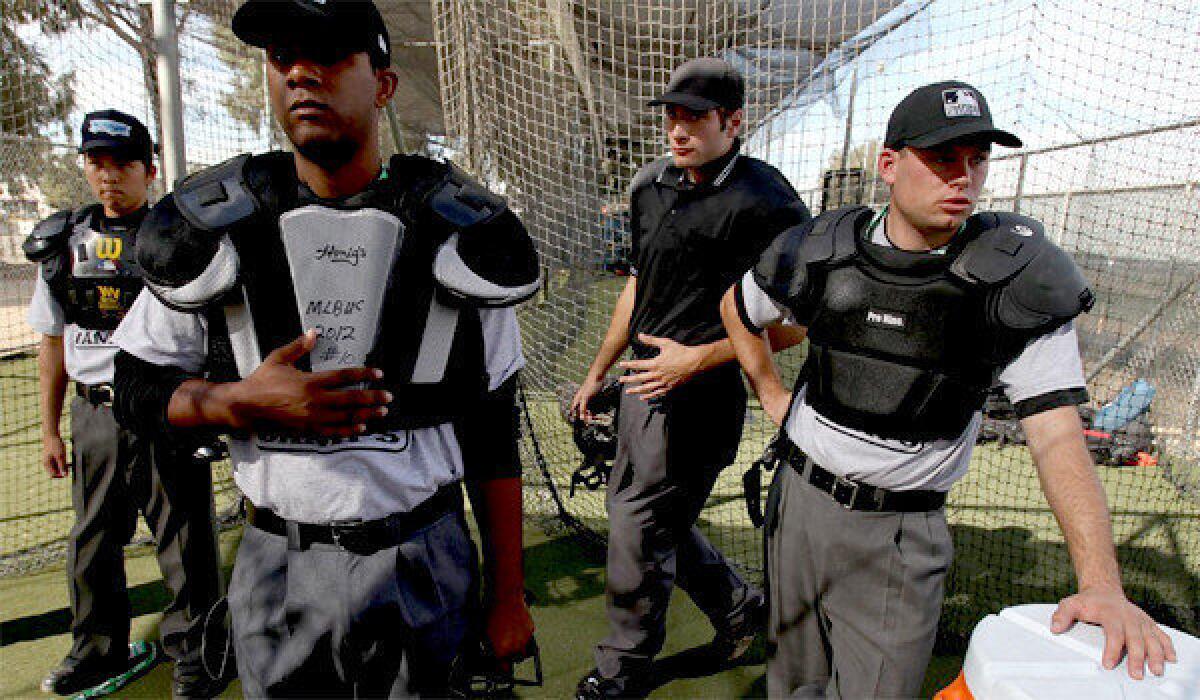Baseball umpires aren’t born knowing all the rules

- Share via
You can’t help but smile while watching Charlie Reliford work at umpire camp in Compton, screaming at his students in a blowsy, animated style. Most good teachers seem to have outsize personalities and an undeniable charisma. That’s Reliford, a screaming tyrant one moment, funny and endearing the next.
Think Jackie Gleason with brick dust in his shoes.
“Have you guys ever actually seen a baseball game before?” he yells after one blown call.
You probably remember Reliford best from Game 2 of the 2000 World Series. He was behind the plate when Yankees pitcher Roger Clemens threw a piece of firewood (a shattered bat) back at the Mets’ Mike Piazza, and quick peacemaking by Reliford prevented World War III from breaking out.
Now working behind the scenes as an MLB supervisor, he was here last week helping with this camp, assisted by four active umps — Mark Carlson, Kerwin Danley, Marty Foster and Marvin Hudson. The intense week-long session is an MLB offering to umpires, from wannabes to those with a few years — and ballpark meals — under their belts.
In fact, about one-third of the students are rank beginners, many of them active-duty Marines gifted with a week at the camp, a possible entry point to the profession for some of them.
“We don’t want you leaning over forward,” says instructor Carlson, as he gives tips on calling balls and strikes. “Concentrate on following it in with your eyes.”
“What scares me the most is the plate work,” says Kimberly Horse, a Marine and the camp’s lone female, who played softball while growing up in New Mexico but had never umped. “I’m comfortable with the base work.”
Her biggest fear, amid the game’s occasional moments of pure chaos?
“Not knowing if I’ll know,” she says of baseball’s arcane rules.
The camp, in its eighth year and boasting a record 80 students, includes four campers from as far away as Japan. Most umpire moves are the same in Japan as they are here, except that there is no punchout move distinguishing a called third strike from an earlier strike, denying a plate umpire that rare moment of theatrics.
“So they all like to work on their punchout move,” says their interpreter.
Interesting times for the profession. On the heels of a well-called World Series, baseball is poised to expand instant replay next season.
“Oh good,” you’re saying to yourself. “Because baseball really needs to be even slower.”
MLB insists that the replays will be done quickly and hopes to keep the process to under a minute, far faster than in football.
Under the MLB system, each manager would get a certain number of challenges. The initial proposal was one before the seventh inning, then two after that. But that may change. Ball and strike calls will not be reviewable.
Decisions will be made remotely, at a video center in New York.
MLB has been testing the system for a couple of weeks in the Arizona Fall League, where it has received good reviews.
Lost in all this, of course, is the human factor, not to mention the classic dust-ups between umpires and managers. In exchange for a few more correct calls, baseball is giving up the most entertaining tirades in all of sports.
Yet, even Reliford, who umped for two decades, understands the need for the change.
“There were times,” he said, “when the four of us would huddle after a close play and say to each other, ‘You know, the only four people who aren’t sure what just happened are us. Everybody else in the whole world knows.’”
::
Friday night lights: This week’s UCLA-Washington game is the Bruins’ first regular-season contest ever held on a Friday at the Rose Bowl. Look for me tailgating at Brookside, dressed like a human flip cup.
Dick Butkus sighting: At his grandson’s freshman Loyola High games, along with Jim Mora’s son, a starting safety.
Best tip in my quest to meet the reclusive former linebacker: Dress like Bart Starr, stand outside his house, and scream: “Hey Butkus, is that all you got?!”
Twitter: @erskinetimes
More to Read
Go beyond the scoreboard
Get the latest on L.A.'s teams in the daily Sports Report newsletter.
You may occasionally receive promotional content from the Los Angeles Times.











